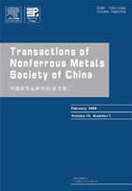Kinetics study on separation and recovery of In-Pb solder by vacuum volatilization
(1. Key Laboratory for Nonferrous Metal Vacuum Metallurgy of Yunnan Province, Kunming University of Science and Technology, Kunming 650093, China;
2. State Key Laboratory of Complex Nonferrous Metal Resources Clean Utilization, Kunming University of Science and Technology, Kunming 650093, China;
3. National Engineering Research Center of Vacuum Metallurgy, Kunming University of Science and Technology, Kunming 650093, China;
4. School of Metallurgical and Energy Engineering, Kunming University of Science and Technology, Kunming 650093, China)
2. State Key Laboratory of Complex Nonferrous Metal Resources Clean Utilization, Kunming University of Science and Technology, Kunming 650093, China;
3. National Engineering Research Center of Vacuum Metallurgy, Kunming University of Science and Technology, Kunming 650093, China;
4. School of Metallurgical and Energy Engineering, Kunming University of Science and Technology, Kunming 650093, China)
Abstract: The vacuum volatilization kinetics of Pb in In-Pb solder was investigated. The results indicate a significant increase in the vacuum volatilization rates of Pb, 25In-75Pb, 40In-60Pb, and In with increasing temperatures from 923 to 1123 K, system pressure of 3 Pa and holding time of 30 min. The mass transfer coefficients and apparent activation energies of Pb and its alloys were determined at various temperatures. Additionally, a kinetics model was developed to describe Pb vacuum volatilization in high-temperature melts. It is obtained that the vapor mass transfer is the factor limiting the vacuum volatilization rates of Pb and In–Pb alloys under the above specified conditions.
Key words: vacuum volatilization; In-Pb alloy; solder; rate equation; kinetics model

